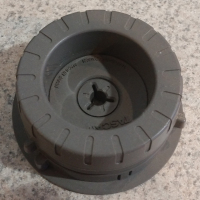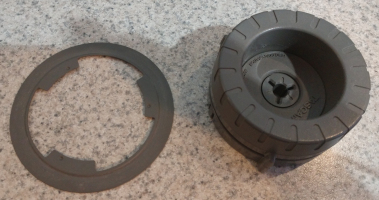General Information
Cleaning and Care
Acrylic, being plastic does require some care to keep it looking good and scratch free. Always clean using a soft cloth, or a shammy cloth, the type used for polishing automobile finishes. Never use paper products as they will scratch acrylic.
The best cleaning products are those specifically meant for acrylic, and not glass cleaners. Never use any type of alcohol to clean acrylic. It can and will craze the plastic!
Store your acrylic reel wrapped in cellophane wrap inside a tape box, and keep the box vertical. This is also better for any tape that might be on the reel.
Do not put other reels or objects on top acrylic reels. This can easily cause scratches.
Keep plastic reels out of direct sunlight, other sources of heat and don't store them on top the tape deck. Sunlight will cause colors to fade over time and heat can cause warpage.
|
Compatibility
Our 7 inch and smaller diameter reels are completely compatible with all tape recorders and tape decks which accept those size of reels. Our plastic reels are slightly thicker than standard, and for a small number of people using larger reels and certain NAB hub adapters, have had issues mounting our larger reels. The issue is entirely with the NAB hub adapter used.
TEAC, TASCAM and Technics hub adapters work well with our reels. The TEAC and TASCAM hub adapters have a metal spacer ring on the back which must be slipped off to use any plastic reel. The spacer ring is meant only for metal reels.
 + + + +Our customers have also reported that the NAB "trumpet" style works well. We are currently prototyping our own NAB hub adapter, based on the Technics design, which will allow our larger reels to be used on all tape decks.
|
Common Terms
Flanges, the two large circular sections of a reel that protect the tape and keep it from inadvertently coming off the reel. They are connected together at, or near the center by the hub.
Hub, the very center part of a reel that holds the two flanges together, allows for the reel to be mounted on a tape deck and holds the tape as it is wound or unwound from the reel.
Hub Adapter, used specifically for larger reels, 10.5, 12.5 and 14 inch reels. Those reels have a central opening for mounting on a NAB tape mounting system. For larger tape decks with a "trident" tape mounting system, a NAB hub adapter is used to allow these tapes to be mounted. A spacer is often used in addition to the NAB adapter for use with metal (aluminum) reels, and left off for use with plastic reels.
Inch ("), a measure of distance in the U.S. and U.K. "standard" system. One (1) inch is defined to be 25.4 millimeters in length.
Millimeter (mm.), a measure of distance in the Metric system. One (1) inch is defined to be 25.4 millimeters. The metric system is the general standard used worldwide.
NAB, the National Association of Broadcasters, a U.S. organization. The NAB have produced standards for the use of reel to reel tape recorders and tape decks, which are and have been used by reel to reel manufacturers worldwide.
Reel, the entire assembly of two flanges and a hub, sometimes called a "spool", and not including and hub adapters. Two reels are used together to hold the tape during playback and recording on a tape deck, one being called the "supply" reel, the other the "take-up", or "empty" reel.
Spacer, a thin piece of plastic or paper, used with large metal reels (10.5" and larger), in conjunction with a NAB hub adapter for the proper mounting of the reel. Sometimes the spacer is an integral part of the hub adapter and should be removable. The spacer is not meant to be used with plastic reels, which are thicker. Improper use of the space, (or lack of) can result in the inability to mount a plastic reel, and may cause the tape to rub against the reel during playback or recording.
Trident, the mounting system on the large majority of tape decks, featuring a round center and three spokes, normally allowing smaller reels from 2 inches to 7 inches to be mounted directly onto the tape deck. Larger reels can also have a trident mounting system, but most have a large opening meant for a NAB mounting system, or the use of a hub adapter.
|
Photographs and descriptions
We make every attempt to ensure that the photographs and descriptions are as accurate as possible, however no photographic process is perfect. The photographs however, cannot hope to match the beauty of seeing our reels in person. What this means, is that if the reel looks good here, it will look great when it arrives at your door. The reel as pictured are not to scale.
|
Copyright © 2020-2022 Reel Clarity™. All rights reserved.
 +
+ +
+





